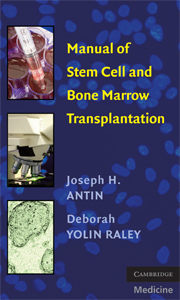Book contents
- Frontmatter
- Contents
- Acknowledgments
- Manual of Stem Cell and Bone Marrow Transplantation
- 1 Rationale for Transplantation
- 2 Types of Transplantation
- 3 HLA Matching in Allogeneic Transplantation
- 4 Stem Cell Source
- 5 Pretransplant Evaluation and Counseling of Patient and Donor
- 6 Conditioning Regimens
- 7 Stem Cell Infusion
- 8 ABO Compatibility
- 9 Engraftment
- 10 Preventative Care
- 11 Transplant-Related Complications
- 12 Graft-Versus-Host Disease – Prophylaxis and Acute
- 13 Graft-Versus-Host Disease – Chronic
- 14 Engraftment Syndrome
- 15 Infectious Disease
- 16 Graft Rejection And Failure
- 17 Gastrointestinal Complications
- 18 Pulmonary Complications
- 19 Veno-Occlusive Disease
- 20 Special Transfusion-Related Situations
- 21 Cardiovascular Complications
- 22 Neurologic Complications
- 23 Cystitis
- 24 Donor Lymphocyte Infusion
- 25 Transplantation: Regulation And Accreditation
- Appendix
- Index
5 - Pretransplant Evaluation and Counseling of Patient and Donor
Published online by Cambridge University Press: 23 November 2009
- Frontmatter
- Contents
- Acknowledgments
- Manual of Stem Cell and Bone Marrow Transplantation
- 1 Rationale for Transplantation
- 2 Types of Transplantation
- 3 HLA Matching in Allogeneic Transplantation
- 4 Stem Cell Source
- 5 Pretransplant Evaluation and Counseling of Patient and Donor
- 6 Conditioning Regimens
- 7 Stem Cell Infusion
- 8 ABO Compatibility
- 9 Engraftment
- 10 Preventative Care
- 11 Transplant-Related Complications
- 12 Graft-Versus-Host Disease – Prophylaxis and Acute
- 13 Graft-Versus-Host Disease – Chronic
- 14 Engraftment Syndrome
- 15 Infectious Disease
- 16 Graft Rejection And Failure
- 17 Gastrointestinal Complications
- 18 Pulmonary Complications
- 19 Veno-Occlusive Disease
- 20 Special Transfusion-Related Situations
- 21 Cardiovascular Complications
- 22 Neurologic Complications
- 23 Cystitis
- 24 Donor Lymphocyte Infusion
- 25 Transplantation: Regulation And Accreditation
- Appendix
- Index
Summary
PRETRANSPLANT COUNSELING
Both patient and donor are completely evaluated before stem cell transplantation. The evaluation should comply within guidelines established by the Food and Drug Administration (FDA), Foundation for the Accreditation of Cellular Therapy (FACT), and other regulations and should be available in written form specific to your institution. Both patient and donor evaluations include a thorough history and physical examination and a series of studies to confirm medical eligibility.
Treatment recommendations should be discussed thoroughly with the patient, donor, and family. The marrow graft procedure as well as alternative forms of therapy, as far as they exist, should be presented as objectively as possible. The risks and hazards of stem cell mobilization and the donation procedure and any other procedures associated with the donation must be explained to the donor as well as to the patient or, in the case of minors, to the donor or patient's responsible family member. Plans for protection of fertility are also discussed at this time. Reading material, videotapes, and other education aides are helpful and should be available. In addition, a discussion of patient wishes regarding aggressive supportive measures (i. e., cardiopulmonary resuscitation, mechanical ventilation, other artificial means of life support), and establishment of a living will or other advanced directives should be included at this time. It is important to point out specifically that some aspects of hematopoietic stem cell transplantation (HSCT) are still considered experimental.
- Type
- Chapter
- Information
- Manual of Stem Cell and Bone Marrow Transplantation , pp. 16 - 22Publisher: Cambridge University PressPrint publication year: 2009



